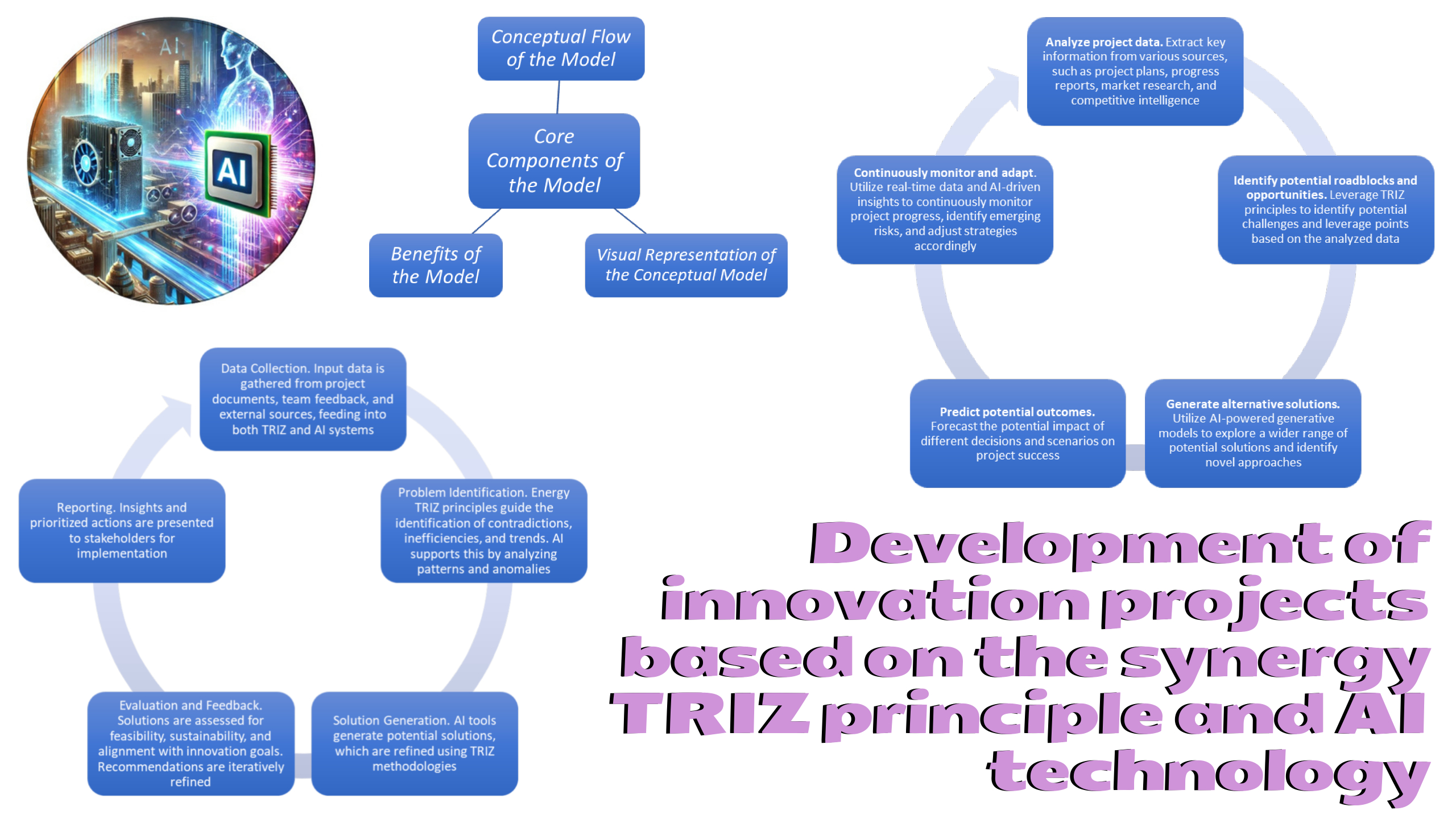Побудова інноваційних проєктів на основі сінергії принципів TRIZ та технології ШІ
DOI:
https://doi.org/10.15587/2706-5448.2025.322052Ключові слова:
аудит інноваційних проєктів, ТРВЗ, штучний інтелект, управління проєктами, прогнозна аналітика, прийняття рішеньАнотація
Об’єктом дослідження є нова методологія побудови інноваційних проєктів, яка використовує принцип синергії теорії рішення винахідницьких задач (ТРВЗ) та інтегрується з технологію штучного інтелекту (ШІ).
Проблема, розглянута в цьому дослідженні, полягає в неефективності та обмеженості традиційних методів побудови інноваційних проєктів, які часто не в змозі всебічно оцінити їхній потенціал, ризики та відповідність майбутнім технологічним тенденціям.
Результатами досліджень є синергетичне застосування принципів ТРВЗ і технології ШІ для проведення комплексних аудитів інноваційних проєктів. Інтегруючи структуровану систему вирішення проблем ТРВЗ з аналітичною потужністю ШІ, пропонується новий підхід для покращення оцінки та оптимізації інноваційних ініціатив. В роботі досліджено, як можна використовувати алгоритми штучного інтелекту для аналізу даних проєкту, визначення потенційних перешкод і можливостей на основі принципів ТРВЗ. Для створення альтернативних рішень і прогнозування можливих результатів, допомоги у визначенні синергії між різними елементами проєкту та зовнішніми факторами. Постійно відстежується та адаптується інноваційний процес на основі даних у реальному часі та розуміння, керованого ШІ.
Відмінністю дослідження є інтеграція принципів ТРВЗ в аудит інноваційних проєктів з використанням систем ШІ. Представлений кейс продемонстрував ефективність запропонованих концептуальної, математичної та процесної моделей аудиту інноваційних проєктів. Як приклад для кейс-стаді було обрано магістерську програму зі штучного інтелекту, яка реалізується в Київському національному університеті будівництва і архітектури (Україна). Дослідження демонструє потенціал цього інтегрованого з аудитом підходу для підвищення рівня успішності інноваційних проєктів шляхом надання більш точних оцінок, виявлення прихованих можливостей та сприяння проактивному прийняттю рішень. Це дослідження сприяє більш ефективним і успішним інноваційним проєктам, забезпечуючи керованими даними, та інтелектуальний підхід до розробки та вдосконалення проєктів. В межах розглянутого кейсу проведено оцінювання прискорення процесів аналізу та прийняття рішень на прикладі програми інноваційного розвитку підготовки магістрів з штучного інтелекту. Було виявлено, що процеси аналізу та прийняття рішень реалізуються у 2.68 рази швидше без втрати якості рішень.
Посилання
- Ladewig, G. R. (2007). TRIZ: The Theory of Inventive Problem Solving. The PDMA ToolBook 3 for New Product Development, 3–40. https://doi.org/10.1002/9780470209943.ch1
- Bushuyev, S., Piliuhina, K., Chetin, E. (2023). Transformation of values of the high technology projects from a VUCA to a BANI environment model. Innovative Technologies and Scientific Solutions for Industries, 2 (24), 191–199. https://doi.org/10.30837/itssi.2023.24.191
- Bushuyev, S., Ivko, A. (2024). Construction of models and application of syncretic innovation project management in the era of artificial intelligence. Eastern-European Journal of Enterprise Technologies, 3 (3 (129)), 44–54. https://doi.org/10.15587/1729-4061.2024.306436
- Roper, S., Du, J., Love, J. H. (2008). Modelling the innovation value chain. Research Policy, 37 (6-7), 961–977. https://doi.org/10.1016/j.respol.2008.04.005
- Love, J. H., Roper, S. (2009). Organizing innovation: Complementarities between cross-functional teams. Technovation, 29 (3), 192–203. https://doi.org/10.1016/j.technovation.2008.07.008
- Rammer, C., Czarnitzki, D., Spielkamp, A. (2008). Innovation Success of Non-R&D-Performers: Substituting Technology by Management in SMEs. SSRN Electronic Journal. https://doi.org/10.2139/ssrn.1314246
- Hidalgo, A., Albors, J. (2008). Innovation management techniques and tools: a review from theory and practice. R&D Management, 38 (2), 113–127. https://doi.org/10.1111/j.1467-9310.2008.00503.x
- Hansen, M., Birkinshaw, J. (2007). The innovation value chain. Harvard Business Review. Available at: https://hbr.org/2007/06/the-innovation-value-chain
- Shin, W.-S., Lee, S.-H., Sue, H.-J. (2024). Fostering Tech Innovation. Tehnički Glasnik, 18 (4), 588–597. https://doi.org/10.31803/tg-20231212081808
- Särner, E., Yström, A., Lakemond, N., Holmberg, G. (2024). Prospective Sensemaking in the Front End of Innovation of AI Projects. Research-Technology Management, 67 (4), 72–83. https://doi.org/10.1080/08956308.2024.2350407

##submission.downloads##
Опубліковано
Як цитувати
Номер
Розділ
Ліцензія
Авторське право (c) 2025 Sergey Bushuyev, Natalia Bushuyeva, Andrii Puziichuk, Denis Bushuiev

Ця робота ліцензується відповідно до Creative Commons Attribution 4.0 International License.
Закріплення та умови передачі авторських прав (ідентифікація авторства) здійснюється у Ліцензійному договорі. Зокрема, автори залишають за собою право на авторство свого рукопису та передають журналу право першої публікації цієї роботи на умовах ліцензії Creative Commons CC BY. При цьому вони мають право укладати самостійно додаткові угоди, що стосуються неексклюзивного поширення роботи у тому вигляді, в якому вона була опублікована цим журналом, але за умови збереження посилання на першу публікацію статті в цьому журналі.








